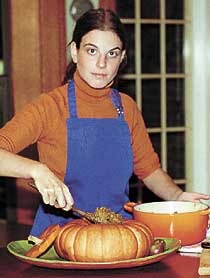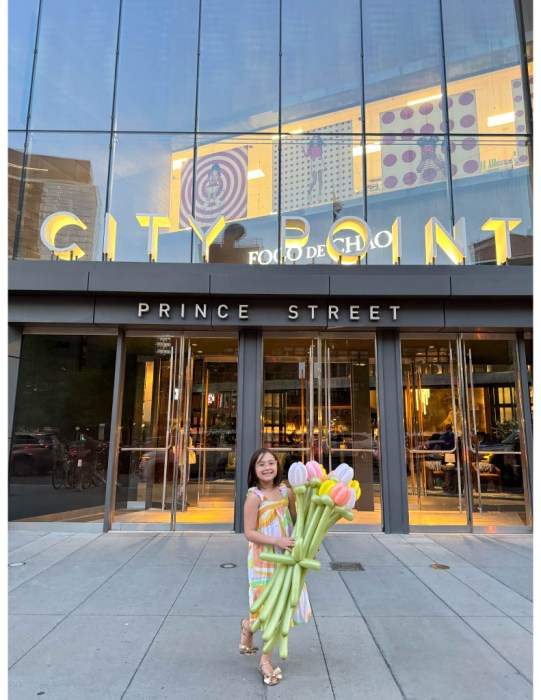Thanksgiving is a harvest-time celebration
in which we give thanks for the bounty of the land and share
seasonal foods with the people we love. While there is nothing
in its genesis to exclude vegetarians, Thanksgiving dinner in
many households is a turkey-centric affair that leaves omnivores
stuffed to bursting and vegetarians picking pecans out of the
pie for protein.
In my previous attempts to change this, I have watched with dismay
as folks bypassed my stuffed tofu on the way to the turkey, or
politely tasted the "squashkey" I built out of squash,
gourds and skewers.
When you get right down to it, my dishes flopped because holidays
are about shared traditions. Therein lies the challenge for vegetarians
who prefer not to alienate family and friends with mocking stand-ins
for time-tested Thanksgiving favorites. So, this November I plan
to avoid rocking the gravy boat and to wholeheartedly embrace
tradition.
I won’t need to search hard for culinary inspiration. The simplest
equation of turkey with fixings is varied and embellished in
every home, and so many of the dishes that round out this meal
are – or can be – meatless. If you or a guest will not eat animal-based
ingredients, take a second look at family recipes and think about
how they can be presented or altered in a manner suitable to
vegetarians. Extra stuffing can be made with a bit more butter
and broth, then baked separately from the turkey. A soup or pilaf
containing chicken stock can be made with vegetable broth instead.
And if you usually sprinkle a little bacon over the Brussels
sprouts, why not serve one bowl with and one without? Making
these simple considerate gestures need not require extra work.
Serving a meal that welcomes vegetarians and meat eaters should
not induce a pre-dinner frenzy that exhausts the cook and delays
the feast. A practical way to save your energy is to do some
advance preparation. For a busy cook hoping to represent vegetarian
tastes, the first course or appetizer table is a good place to
start. Cheese terrines and nut pates are elegant starters that
can be made a few days ahead and set out while turkey or pie
still monopolizes the oven.
Store-bought delicacies can also be served as pre-dinner nibbles.
An easy appetizer that everyone loves is an assortment of little
savory phyllo dough triangles containing cheese, spinach or meat,
which I buy frozen from the grocery store or from a bakery. A
local bakery, which I recommend, is Mansoura Middle Eastern Bakery
at 515 Kings Highway. [They even do mail order! (718) 645-7977]
Phyllo triangles are also available in the freezer cases at Sahadi
Importing, 187 Atlantic Ave., and Eagle Provisions, 628 Fifth
Ave. These pastries can be toasted, then set out on separate
platters, so that meat and vegetable pastries are not confused.
When choosing recipes for the main course, emphasize tradition
and togetherness by serving time-honored holiday foods that harmonize
with the rest of the meal, yet are substantial enough to be enjoyed
on their own.
Many holiday flavors can be featured in dishes that incorporate
mainstays of the vegetarian diet such as nuts, cheese, legumes
or eggs. For example, squash and sweet potatoes can be combined
with eggs, cream and cheese to make savory custards or souffles
that really feel festive.
And at my house, Thanksgiving would not be complete without my
mother’s lentil and squash casserole. Somehow, the curry flavor
is an unexpected complement to just about every food on the table.
(See "Curried lentils with squash" recipe at left.)
Another traditional food is the chestnut. This high-protein,
low fat nut is no longer served as often as it deserves to be.
Buy them fresh, jarred or frozen and consult a cookbook for instructions
on how to add them to stuffing, puree them or roast them with
Brussels sprouts. Chestnuts have a sweet nuttiness and slightly
smoky crunch that turns any dish into holiday fare.
During the holidays, take inspiration from the plentitude of
foods available to us and try using a few classic ingredients
and some winning flavor combinations to create new traditions
that everyone will look forward to seeing each year. After all,
the pilgrims never considered the mini marshmallow, but whoever
did ushered in a new era for yams.
If vegetarianism is new to your family’s Thanksgiving, be assured
that the fruits and vegetables of fall have always played a major
role in this holiday. That first year, farmers, hunters, cooks
and guests all reveled in a cornucopia of seasonal foods, and
everyone went to bed feeling well fed and lucky to be together
in America. No matter how much we as a nation have changed, that
part of Thanksgiving has never been more present.
Curried Lentils with Squash
This dish can be made in advance
in a large casserole, then reheated in the oven or on the stove.
It is equally good warm or hot, so don’t worry about serving
it immediately. For a festive presentation, I like to put the
cooked lentils in a big roasted pumpkin. When the lentils are
served, some of the pumpkin can be scooped out with every portion.
Serves 6 to 8
5 to 6 cups vegetable stock
1 1/2 cups lentils
1/4 teaspoon turmeric
3 tablespoons extra-virgin olive oil
1 teaspoon ground cumin
1 teaspoon ground coriander
Pinch cayenne pepper, or to taste (optional)
4 cups peeled, cubed butternut squash (1 small squash)
1 onion, diced
1 clove garlic, minced
1 teaspoon grated fresh gingerroot (or 1/2 teaspoon ground ginger)
1/2 teaspoon salt, or to taste (omit if using salted stock)
1 tablespoon fresh lemon juice, or to taste
Chopped parsley or cilantro for garnish
1. Pour 5 cups of the stock into a large pot and bring to a boil.
Add the lentils and turmeric and reduce the heat to medium low.
Simmer, partially covered, for half an hour, stirring in additional
stock if the lentils seem dry.
2. Meanwhile, heat the oil in a heavy skillet over medium heat.
Add the cumin, coriander and cayenne and cook, stirring, until
fragrant, about 1 minute. Add the squash, onion, garlic, ginger
and salt, and saute, stirring, until the onions begin to brown,
about 10 minutes.
3. Add the squash mixture to the lentils, cover the pot, and
simmer over medium low heat until the squash is tender, about
20 minutes. Stir in lemon juice to taste and garnish with parsley
or cilantro.
Whole Roasted Pumpkin
1 large (6- to 8-pound) cheese or sugar type eating pumpkin
1 to 2 tablespoons melted butter
Salt and black pepper to taste
Tip: When choosing your pumpkin, avoid decorative pumpkins. Pumpkins
for eating should be bright-colored, with the stem still attached,
and a moist, heavy feel. Look for the sugar or cheese varieties
that do not exceed 8 pounds, and ask if you’re not sure if it
will make a good eating pumpkin. Most carving pumpkins, often
referred to as field pumpkins, are larger and less flavorful,
while the tiny pumpkins that are sold to be decorative are often
coated with shellac.
1. Preheat the oven to 350 degrees. Cut a lid out of the pumpkin.
2. Scoop out the seeds and pulp. Add salt and pepper to the melted
butter and brush the interior of the pumpkin with the seasoned
butter.
3. Place the pumpkin on a large-rimmed baking sheet and roast,
with the lid on, until tender, about 1 hour. Uncover, let cool
slightly, then transfer to a platter and fill with the lentils.
Zoe Singer is a Brooklyn native.
She writes about food and lives in Sunset Park.























